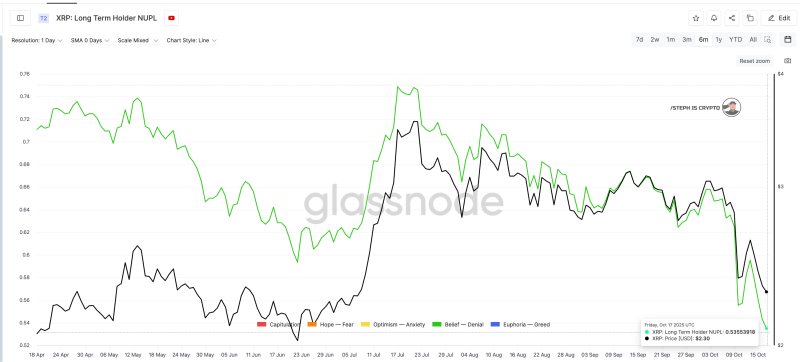Long-term XRP holders are showing signs of exhaustion after months of declining prices and fading optimism. This means investors are sitting on smaller unrealized gains, with some now slipping into losses. History suggests these conditions often come before trend reversals, as capitulation clears the way for fresh accumulation.
What the Data Shows
Recent Glassnode data shared by STEPH IS CRYPTO reveals that XRP's long-term holder Net Unrealized Profit/Loss (NUPL) has dropped to 0.535. The chart tracks two important metrics: the green line represents NUPL, which measures long-term holder sentiment, while the black line shows XRP's price movement, currently hovering around $2.30. Earlier this year, XRP's NUPL sat near 0.72, reflecting strong confidence. Since then, it's fallen below 0.55—a zone typically associated with anxiety and doubt. Both price and sentiment have declined in tandem, pointing to weakening confidence among committed holders.

Net Unrealized Profit/Loss measures whether investors are collectively in profit or loss. Values above 0.7 usually signal euphoria or greed, which often appears near market peaks. Readings around 0.5 indicate anxiety or disbelief, levels that frequently align with market bottoms. Previous drops to this range in 2018, 2020, and 2022 came during exhaustion phases that preceded longer-term recoveries. The current reading suggests XRP might be nearing another accumulation zone if selling pressure continues to ease.
Why Sentiment Has Shifted
Several factors have contributed to XRP's on-chain fatigue. Liquidity has rotated toward higher-momentum assets like Bitcoin and Solana, reducing capital flowing into XRP. After a strong rally in early 2025, many early holders have taken profits. Regulatory uncertainty persists despite Ripple's legal progress, with ongoing debates around stablecoin oversight and exchange compliance cooling enthusiasm. That said, long-term fundamentals remain intact—on-chain data shows a steady increase in long-term holder supply, suggesting dedicated investors are quietly accumulating during the downturn.
 Peter Smith
Peter Smith

 Peter Smith
Peter Smith


